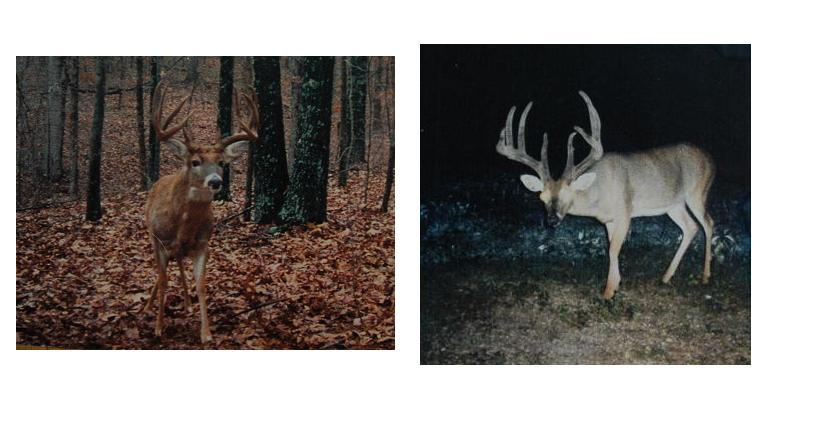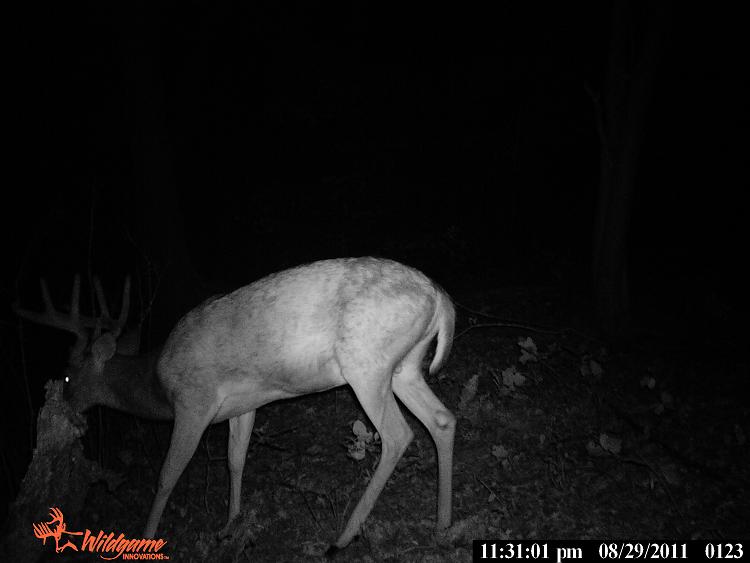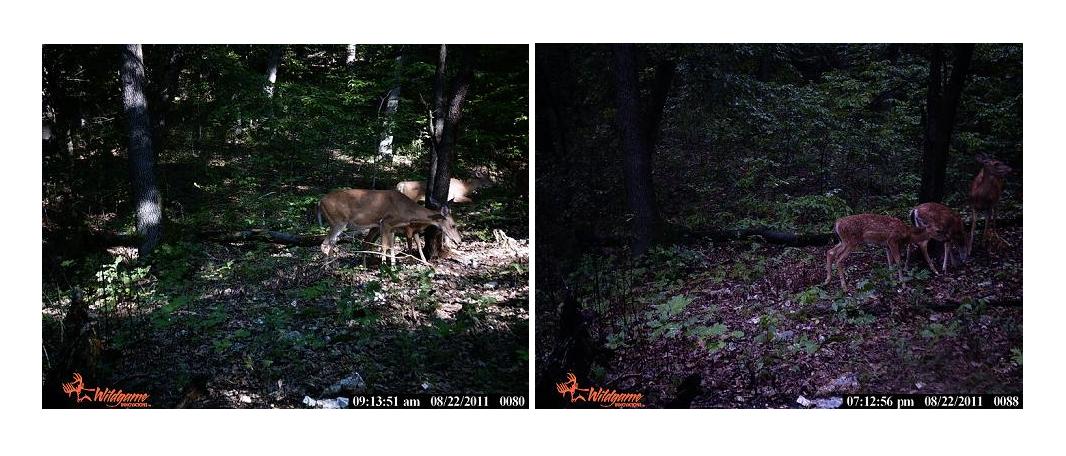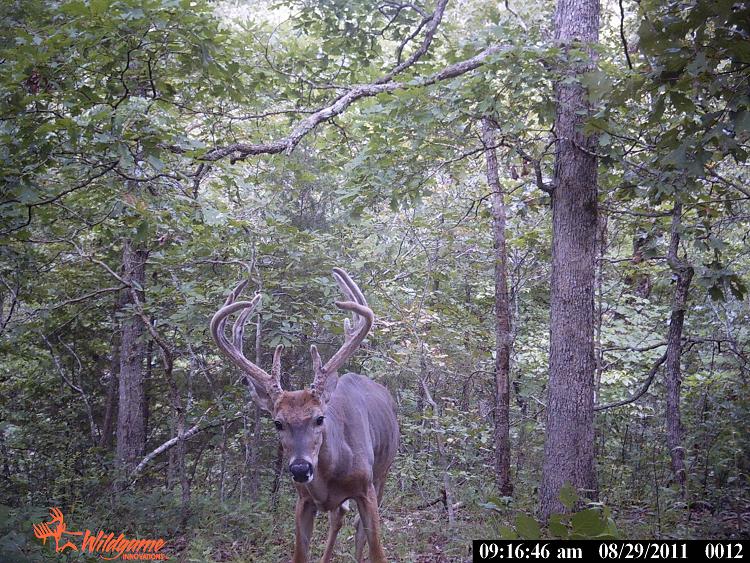How To Hunt Big Whitetail Bucks
Ed Johnson 09.29.11

After fifty years of serious bow hunting, I have looked back many times at the mistakes and successes I have had during those years hunting big whitetail bucks, especially what I refer to as super bucks. Here in southern Missouri these big bucks are in the 140 to 190 range. Now understand, these southern Missouri whitetails do not have the same abundance of food as their brethren from the northern part of the state. Crop land is relatively scarce compared to the bean and corn country up state. At any rate, a 140 to 190 buck south of I-70 is very respectable, and the dream buck of any hunter in North America.

How many books and magazine articles have I read over the years trying to figure these brutes out? How many hours of scouting have I spent? Honestly, I did not keep track, but I did make many notes and lived for the pursuit of these super bucks. Spending time in the woods and constantly scouting is the best way for an individual hunter to learn how to build a strategy for his big buck. Know your territory as if you could hunt it blindfolded!
It wasn’t until 1990 that I woke up to the fact that bucks, even big bucks, are creatures of habit, more than we give them credit for if they are left undisturbed for most of the year. It is only during the rut that they become totally unpredictable. They appear to be oblivious to their life before the rut. They are focused on one thing that you can be sure of, however: does in heat! The buddy buck relationships that occur when the bucks run together abruptly turn them into highly competitive individuals exerting their dominance over weaker bucks. This phenomenon begins to occur in late October and often runs into middle December. Most whitetail will still be on the prowl through a secondary breeding period in December. This is an excellent time to hunt the big brutes.
 Now, let’s back up for a moment. Prior to the rut, as far back as May, I put out a good mineral supplement consisting of dicalcium phosphate and a mild stock mineral that I mix with the phosphate. It is always good to research your mixture and talk to a wildlife biologist to get your proper recipe. You want to assist the deer in a proper diet for antler growth year after year. I do not buy off the shelf supplements, mainly because of their cost. You can pay up to $15 for a gallon or less a bag, or spend $40 and mix yourself 200 lbs of your own recipe. It’s a no brainer!
Now, let’s back up for a moment. Prior to the rut, as far back as May, I put out a good mineral supplement consisting of dicalcium phosphate and a mild stock mineral that I mix with the phosphate. It is always good to research your mixture and talk to a wildlife biologist to get your proper recipe. You want to assist the deer in a proper diet for antler growth year after year. I do not buy off the shelf supplements, mainly because of their cost. You can pay up to $15 for a gallon or less a bag, or spend $40 and mix yourself 200 lbs of your own recipe. It’s a no brainer!
Here are some tips for mineral and lick placement:
- Locate a travel route to and from the bedding area that leads to a central hub of ravines or shallow ridge flats and has slope on both sides. Also check trails that lead to bottom land, especially where a river or stream is present or any water or food source.
- Glass these areas months before the season opens. Learn where the bucks are feeding and bedding. I’ve found that glassing in the evening to be more productive.
- If undisturbed, a bedding area is used pretty consistently. Look for more frequent droppings in an area. Large buck stools look like large wafers whereas doe stools look like goat or rabbit droppings, they are small in size.
- In late winter when the snows come, get in the woods and back track large buck tracks. It will take you right to his bed. Since I hunt private land I mark that spot with a small streamer for future reference when I scout later in the season. Snow tracking is one of the most revealing techniques to find big buck habitat.
- On the 300 acres I hunt, I put out 7 to 8 mineral sites. Why so many? Deer like to rotate and circle their territory. Usually, this covers a square mile or more. They can range further but I have found that they stay pretty close to a particular area where they are comfortable. By having numerous licks, they have a reason to stay close in a tighter proximity. When there are numerous does around, they have no reason to leave.
- Keep a game camera at each mineral location. Technology allows us that opportunity. I use an inexpensive camera that simply gets the job done and is not hard on battery use. It tells me what bucks are using certain licks the most and how much they move around. Believe me, you will learn a lot about your bucks!

- Put mineral licks in thick cover as well as travel routes. Look for a trail that you don’t think you would hunt because it is too thick, then hunt it.
- Avoid setting licks too close to bedding areas. Two hundred yards would be a good standard if the prevailing wind is in your favor.
- Put the lick closer to the corridor where the buck will go to feed. Watch for big acorn trees: great places for a lick, especially when there are no crops nearby.

- Check your cameras throughout the summer months. Hot weather will drive bucks and does to the salt. I check the cameras every week to two weeks and set my intervals on time lapse to 1 minute apart. Hundreds of pictures are not as important as one good quality buck caught on a frame.

- Once you have a good buck on your camera, don’t disturb the area too much. I usually check cameras around noon to two p.m. when deer tend to not move so much.
- As the season gets closer, you will know your bucks on a first name basis. Start watching for fresh rubs and early scrapes. It is very important to take notes and set you up a log book so you can record times and dates when the bucks were at your lick.
Now, back to how to hunt the big bucks and analyze what all of this work with mineral is good for. Two main reasons that this gives you the maximum opportunity to draw in big bucks:
Antler growth: Bucks grow their antlers from the phosphorous and calcium which their bodies absorb primarily from their ribs and cartilage. When you put out these same supplements you are helping to increase their antler growth rate to reach its fullest genetic potential. It adds to their diet and takes away some of the body stress during their time period of antler growth. That is why it is important to get your mineral out there in early spring.

Doe activity: Does frequent the mineral just as much, if not more, than the bucks. Bearing the young also makes bodily demands on their diet. During the hot summer months the does will go to mineral and salt almost daily as my cameras have shown. When the young are born, producing milk becomes priority for the doe. Again, the mineral plays an important role in keeping her strong and healthy. The end result is that the does begin to frequent the mineral all year long and hence, the bucks will follow! You want does if you want to have more bucks but you also need to manage the doe population in your hunting area.

I am of the old school and to this day have never put in a food plot. Mineral licks save me a lot of work and expense. It is simple arithmetic and easy to maintain. When the season arrives, the deer are ready and I am ready for the pursuit. Now is the time to activate your strategy and follow these steps religiously:
- Hunt where you have had the most activity with your bucks.
- Know where your acorn mast or food source is.
- Pay attention to the locations your does frequent! They will be leading the bucks to you, even during the rut. Does do not stop eating while bucks hardly eat at all during the rut.
- Be sure to get your travel routes down to one or two well used trails.
- Remember that bucks know where does travel and the scent of a doe in estrous is a billboard to a buck.
- Use scent drippers and mock scrapes to create competition among dominant bucks. Place them over real scrapes as well. Be careful to minimize your own scent by wearing rubber boots and disposable gloves when tying the dripper to a limb over the scrape.
- Place your stand about 20 yards off your lick or scrape and at least 16 feet high. 20 to 22 feet is best.
- If there is no action on the third day, move and let your stand sight cool off. Always have multiple locations to set a stand.
- Place your stands so you can have good visibility in all directions if possible. A little trimming may be necessary.
- When spotting a doe during rut, get ready! A big buck may be close behind. They will be moving faster than usual so a grunt call will often stop them for a few seconds.
- Big bucks mate with mature does more often than not. Younger bucks mate with younger smaller does.
- Pay attention to what you learned on your cameras and scouting.
- Pay attention to the moon phase. My favorite pre-rut time to hunt is the last 10 days of October and the first 9 days of November, just before firearms season.
- In the old days before cameras I used fishing line across trails about 4 to 5 feet off the ground to see if “antlers” would trip the line. It was very effective to check traffic! A good rack would snag the line!
- Big bucks like big timber and thick brush escape routes nearby. Take notice!

- Don’t hesitate to hunt on the side of a steep hill leading to a river or stream. I have found many good trails full of big deer that are so steep I could hardly walk them. Remember, think of a deer as a goat, they can go anywhere.
- Watch wind and thermals. Thermals rise in the morning and fall in the evening.
- Hunt at least one really thick area where you know there is a trail. My favorite in a river bottom or up at the top of a ridge next to thick cover.
- Bucks will stay with a doe for several days after breeding her and will breed her several times. During that time, she will lead him to you if you are in the right spot.
- I spray estrous scent from my tree stand about every 15 minutes. Just one short tap on my spray bottle.
- Prior to the rut in early October, your travel routes and acorn locations will pay off. After the rut in late December, replenish your mineral licks because bucks are worn down and need to replenish their diet to build strength back.
- Hunt cold weather and late season! Visibility is great and big bucks feed daily up in the day. They begin to adapt back to their old habits and you have them right in your lap.
The photo illustrations shown here are all off of one 300 acre tract in 2011. I share these with you to illustrate what can be happening and you will not be aware of it. Cameras tell the story, build up your confidence, and produce bigger bucks or at least increase your percentages!
After 50 years of bow hunting, my stubbornness to adjust to technology has been slow to change. I still believe in doing things the old traditional way of our ancestors. It teaches us to be woodsmen, much like a trapper, learning the ways of the animals we pursue. It is very important to teach these ways to our young people first, then let them use new technology if they choose.
In the meantime, the season is here again and my summer scouting has told me what I need to know. I am packing up the Chevy pickup and heading to the woods. Good luck with your hunting and THINK BIG!

